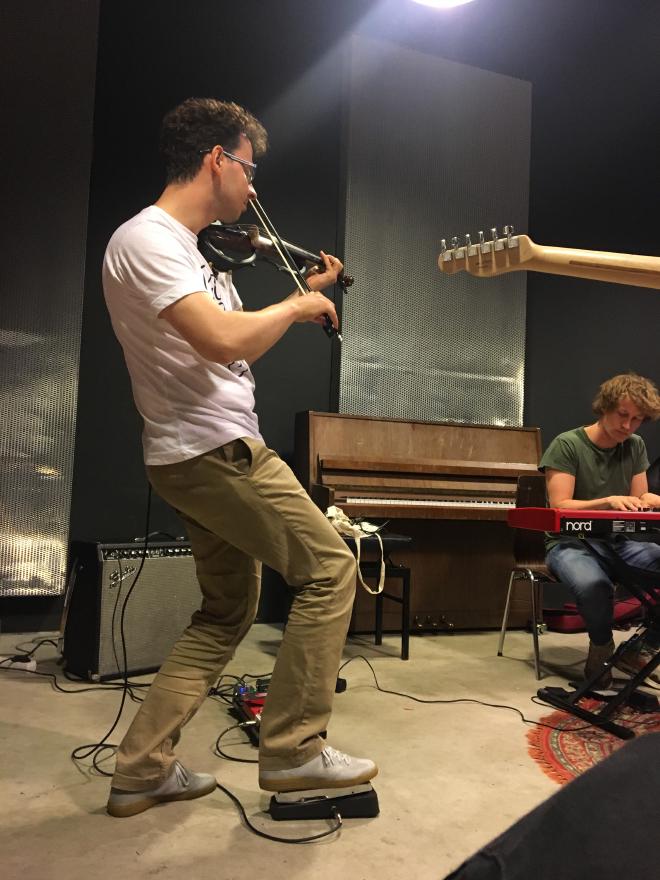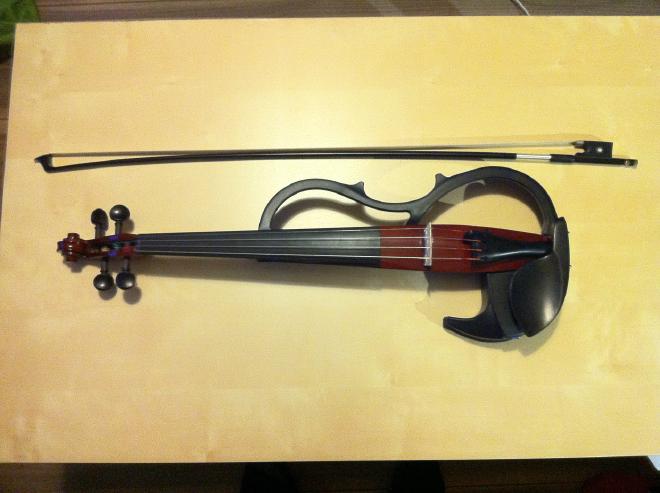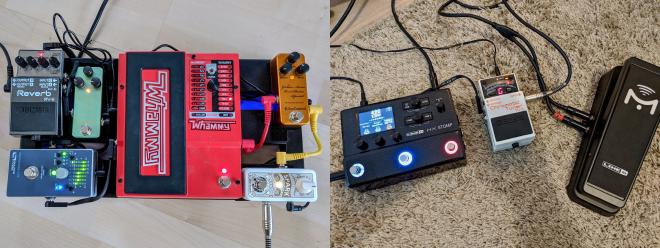Non-classical music playing guide for classically trained musicians
Table of Contents
I went to music school as a kid. Ages 7 to 13 I studied classical violin and basics of music theory. I played in duos, trios, and orchestras. Even as a college student, despite my amateurish skills, I’d still find decent orchestras I would join and play many concerts with. All this, despite my slight disdain for classical music with its pompous ethos and pretentious audiences. I stopped playing after moving abroad about a decade ago, leaving my violin behind me, thinking the music performing chapter of my life was over.
Imagine my surprise when some years later I found myself jamming cave music with my friends, now a software engineer at the age of 34.

What if you are, like me, a classically trained musician who’d, too, like to indulge themselves in cave music? What’s your path? And how hard would it be?
(Before you get upset and start writing angry comments, bear in mind this post is written in good will. I know that I’m not experienced, and that there’s a ton of information this silly little guide doesn’t cover. It’s fine. I still think the advice below can be helpful.)
First thing you need to know, is that you’ll have it waaay easier than people that never went to music school. You know the basics of music theory, you know about chords and maybe some harmony, and you can read sheet music. Heck, maybe you can even play your instrument relatively well! But what nobody ever taught you is the engineering side of music. You probably don’t know how to play with amplification. And you most likely have no idea about what you need to sound good with instruments that are amplified, how to be able to hear yourself play, how to record, and how to venture beyond your own instrument, perhaps into the realm of synthesizers, samplers, and other magnificent ingredients of electronic music. In my case, becoming relatively knowledgeable about those things took a better part of two years, and lots of trial and error (with an emphasis on “error”). What follows is my advice, written from a perspective of a violin player who plays sort-of-jazz, so that you don’t have to spend as much time (and money) on errors of your own.
Electrifying your instrument
If you want to play rock or jazz or some sort of electronic music, chances are you’ll need amplification. Even if your instrument is relatively loud, once you add a drummer into the mix, it likely won’t be loud enough. And sure, you can just play very loudly, but that will make hearing yourself difficult.
Wind instruments have no choice, and they have it hard: you need a microphone, a preamp, and then you feed either into the PA or an amplifier, depending on what sort of sound and control you want. Why is that hard? Because microphones and preamps aren’t cheap, and they aren’t necessarily easy to setup. If you play a brass instrument, for jamming purposes going without a mic will likely be fine, especially if you talk to your drummer. (Bribe them with beer!)
Piano players have it a bit easier. If you really want to, you can rent rehearsal rooms with grand pianos in them, and if they have grand pianos there’s a solid chance they will be setup with microphones, so you’ll have your work cut out for you. At the same time, if you’re a piano player, buying a good, portable, electric piano or synthesizer will cost you less than €2k, offer lots of sonic possibilities and usually a built-in preamp that will let you connect straight to the PA. So just get that Nord electro and be happy.
Finally, we get to string instruments. String players have it best, because they are offered a choice: electric instruments or amplification via pickups attached to acoustic instruments. You can go either way, but as a beginner you should probably go for the electric instrument. Here’s why.
Acoustic violins, violas, cellos and double basses are expensive and fragile. They are fussy when it comes to humidity and temperature, and they don’t like having beer spilled on them in a bar you’re playing at. You don’t want them stolen, either. Acoustic guitars are less expensive and offer a vastly different sound and style, so they’re a bit of their own thing, but fragility argument applies to them as well. An electric violin/cello will cost you a fraction of what a decent acoustic instrument will, and you can toss it around without worrying about damaging your precious 100+ year old investment. They are easy to amplify, they usually come with built-in preamps, and their sound is easily moldable by effects. Often they are also relatively silent when unplugged, which makes them handy for practicing at home.

Getting a good amplified sound using pickups attached to an acoustic instrument is expensive. You need a quality pickup and a preamp, which will likely set you back at least €1k. It’s cheaper than buying an electric instrument (guitar being an exception), though, and a well-amplified acoustic instrument offers superior dynamic range and sound (unless you really want that fusion sound).
Amplifiers
Here’s what I learned after a couple of years of playing my electric violin: I don’t need an amplifier. You may need one, especially if you play the guitar, but you probably don’t need a big expensive one.
First use case is home practice, and let’s be honest, you won’t be playing too loud at home, and you can get by with a small amp. Get a used one and you’ll find something decent for less than a €100. For practicing with a band you’ll likely be renting practice rooms or studios, which will come equipped with PA systems and amplifiers. For gigs, well, in small venues your small amp will probably be fine, and bigger venues have their amps and PA systems.
Pedals
I’ve seen musicians plugging their newly acquired electric or amplified instrument straight into the amplifier, I was one of them. It’s OK to do it, but you’re missing out. Effects pedals not only broaden the sonic capabilities of your instrument, but can also vastly improve the sound quality, allow looping, controlling other electronic instruments, and all this for relatively little money. The thing you need to know about pedals (which I did not) is that their behavior varies significantly from one instrument to another. It’s pretty obvious when you think about it: a sound wave produced by a pluck of an electric guitar string differs greatly from the one produced by blowing into a saxophone or bowing a cello. That’s why most of the advice you find online about what pedals you should buy applies mostly to electric and bass guitars, but not necessarily to bow instruments or the brass section. Here’s my advice:
- Reverb pedals. By far the most important pedal you can buy if you play your instrument with a bow, also an amazing pedal for wind instruments. Reverb pedals give your sound room and body, and in my opinion no other pedal will improve the sound quality of your amplified instrument like a good reverb pedal will. It’s worth spending extra to get a great one if you can afford it.
- Equalizer (EQ) pedals. EQ pedals let you shape the sound by specifying which of the frequencies should be boosted or reduced. This can be particularly useful for violin players that want to get more low- and mid-range sounds out of their instruments, or cello players that want to sound more like a double-bass.
- Delay pedals. Short delay can be great for staccato sounds in wind instruments, also for pizzicato in strings.
- Octaver/pitch shifting pedals will possibly allow to expand the range of your instrument, and can be a powerful creative tool.
- Finally the overdrive pedals—you’d think there’s no use for them outside of blues, rock and heavy-metal styles, but you’d be wrong. An overdriven sax or slightly overdriven strings can sound amazing, but they require a good quality overdrive. Look for midrange-heavy, crunchy ones.

On the right, my even smaller “pedalboard” from May 2020. Signal comes into the tuner, and then to Line6 multi-effect stomp box. And there’s an expression pedal. And that’s it.
There’s of course many more types of pedals that can be fun to play with, and I employ you to dive into the /r/guitarpedals community to learn more about different setups people have, but at this point you might be asking yourself: why don’t I just buy a multi-effects pedal instead?
There was a time when you’d be sacrificing sound quality, but, controversial as it may be in some circles to say it, I don’t think that’s the case anymore. There are some great multi-effects pedals out there and while they cost plenty, they are still cheaper than buying a lot of individual good quality pedals, and you don’t have to worry about pedal boards, power supplies, different polarities and voltage requirements, etc. It’s a matter of personal preference and to some degree convenience. I’ve actually been using a multi-effects pedal for a while now, and while I appreciate the fact that it’s compact and easy to setup, the directness of controls of individual pedals is certainly something I miss.
Recording
Recording is hard.
If you just want to record yourself, all you need is an audio interface for your computer (those needn’t be expensive) and some way to connect your instrument into it. This is where it gets slightly tricky. If you play an amplified instrument, like an electric bass or generally something with a pickup, all you need is an amp that has a line out, or, preferably, a DI box. Here’s a pro-tip: many multi-effects pedals come with line-out and built-in DI capabilities, some even serve as audio interfaces so that you can plug your instrument on one end and connect USB to a computer on the other. Think about it if you’re on a budget and recording is important to you.
Now, if your instrument cannot be easily amplified with pick-ups and you require a microphone, you’re in trouble. Microphones are expensive. And recording via microphone requires an audio interface that supports 48v phantom power, so make sure you don’t get a very cheap one that don’t. And on top of that once you record using a microphone, you need to take into account the acoustic properties of the room you’re recording in. Like I said, it’s hard. But there are some cheap and reasonable options out there, so do some research, talk to the people on reddit, and you’ll be fine.
Finally, we come to the sad topic of recording bands. Recording bands sucks. It’s very hard to do right, and… my unpopular opinion is that you shouldn’t even aim at that. Cheap-ish portable recorders will do a great job, hell, even new smartphones (iPhones are particularly good at that) will record a band well enough so that you can use it for tracking down mistakes and learning from them. Because that’s what you really want, you need to record your band continuously so that you know what to improve. It’s your best “debugging” tool. Once you have enough material and are ready to record something, my advice would actually be to… rent a real recording studio with real sound engineers. I know it sounds silly, but in western Europe rates are around €1000 per three hours of recording which should do the job for an amateur. It’s certainly possible to build a recording studio for under a grand, but it will involve a lot of work, cost a lot of time, and require tons of knowledge. So, food for thought.
Playing something else than your main instrument
Now that you amplified your sound, found an amp or connected to a PA system, chose your pedals and you are able to record, it’s time to figure out how to build a “band” on your own. And I mean a band where you play all the instruments.
I mention this because my target audience is adult, which means that perhaps the ability to play with friends on a regular basis isn’t something that should be taken for granted. I know it wasn’t in my case, and I’d imagine I’m not alone here. So how do you play on your own and not be bored? Let me walk you through what I’ve experienced.
First, loopers. Loopers can be amazing, and are an invaluable practice tool. Think of them as metronomes that aren’t boring first, and the best exercise in harmony second. Loopers come in all shapes and sizes, the bigger they are, the more complicated they get. There are videos all over YouTube of creative musicians doing amazing things with loopers, but they do have a limitation, namely that it’s tricky to make interesting music that consists of more than 3 chord progressions even with the most advanced looper. Which brings us to computers.
Most of us have some sort of laptops or desktops that are fairly new. They don’t even need to be particularly powerful these days, unless you’re mixing Kanye’s latest album. Any relatively new computer will be able to run a digital audio workstation (DAW) of your choice effortlessly, and that DAW in turn will allow you to create tracks, scenes, patterns, etc. There’s a lot of choice when it comes to software, and despite it looking very complicated at first, DAWs aren’t hard to learn. And once you know one, you’ll be able to adapt to a different one relatively easily. Pro-tip for Mac users here: every new Mac comes with Apple’s Garageband pre-installed, and it’s actually a pretty decent piece of software.
There’s a recent trend online of getting away from a computer for music production, which it appears to me is particularly strong amongst the non-professionals. We, amateurs, that is, don’t necessarily need the robustness and feature set of Pro Tools, because we’re not producing music in a professional studio. Our jobs however increasingly require us to spend whole days in front of a computer, and we appreciate getting away from it every once in a while. Also it’s fun being able to get that tactile feedback of hardware that’s made for making music, it gives a feeling of playing an instrument rather than operating software. There’s great choice available both when it comes to standalone synthesizers, samplers, or groove boxes, as well as physical DAW controllers, and playing with them is a lot of fun. And then of course there are synthesizers in pedal form, that can allow you to alter your sound or even simulate a small band. And then of course there are pedals that allow you to control synthesizers and other instruments via MIDI. Possibilities truly are endless here (watch out for that credit card limit though).
After reading all this (if you even made it this far) you might be wondering: what’s the point of me writing an article like this with a classically-trained musician in mind?
It has been my somewhat surprising experience that many people went to some sort of music school as a child. They play the oboe, the piano, or the trumpet, and since they stopped their musical education, they stopped playing. I was one of those people and I thought that my situation was somewhat unique, but it wasn’t. There’s so many musicians that don’t play anymore. I thought that’s sad, because music is the best thing there is, and I thought I could encourage those that, like me, thought their best jamming years are long behind them, to rekindle their relationship with their instruments and make that bass droppp.
Also, seeing that we’re all on lockdown, in the words of the poet:
It has to start somewhere
It has to start sometime
What better place than here?
What better time than now?
Don’t let your dreams be dreams.